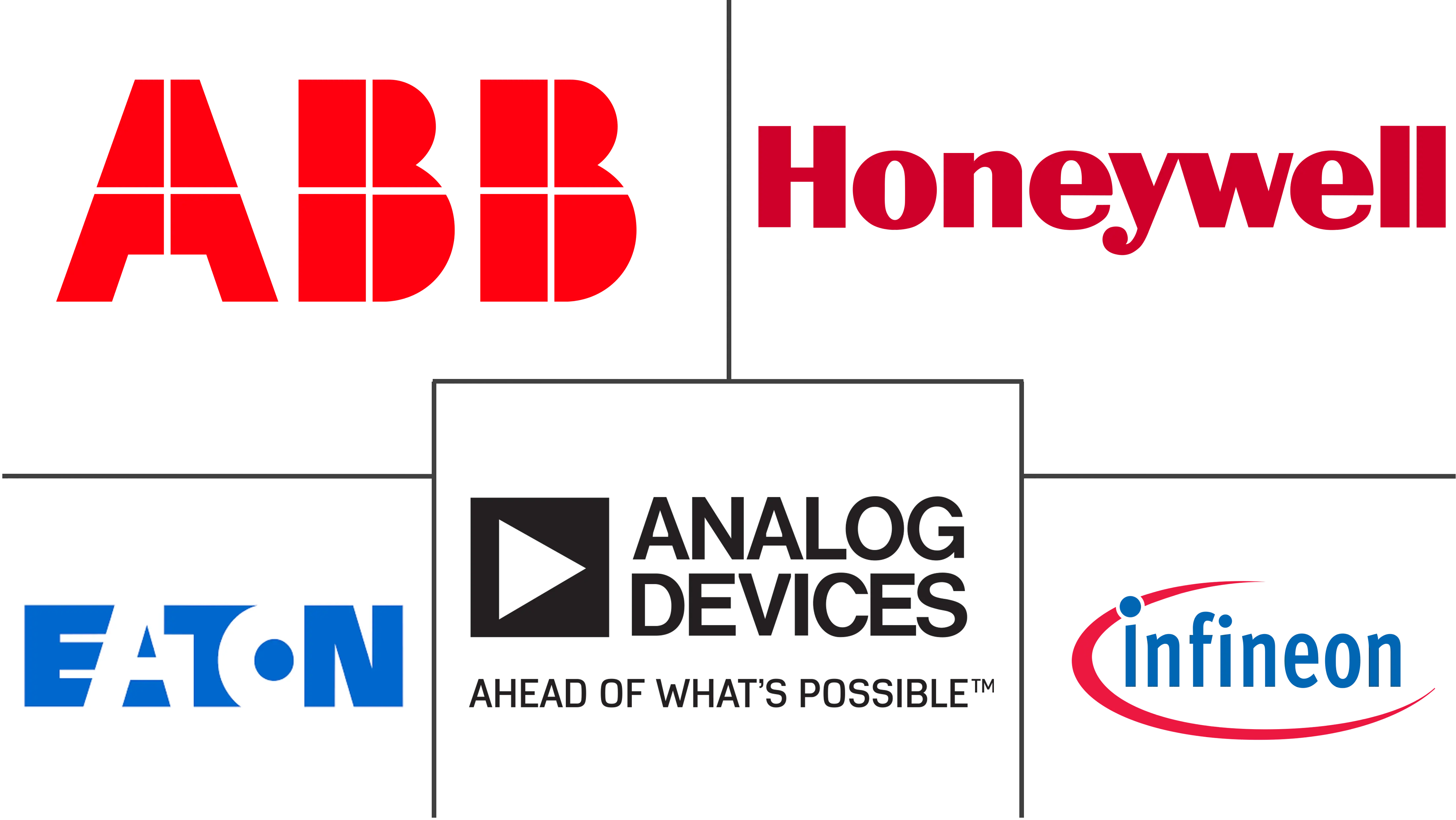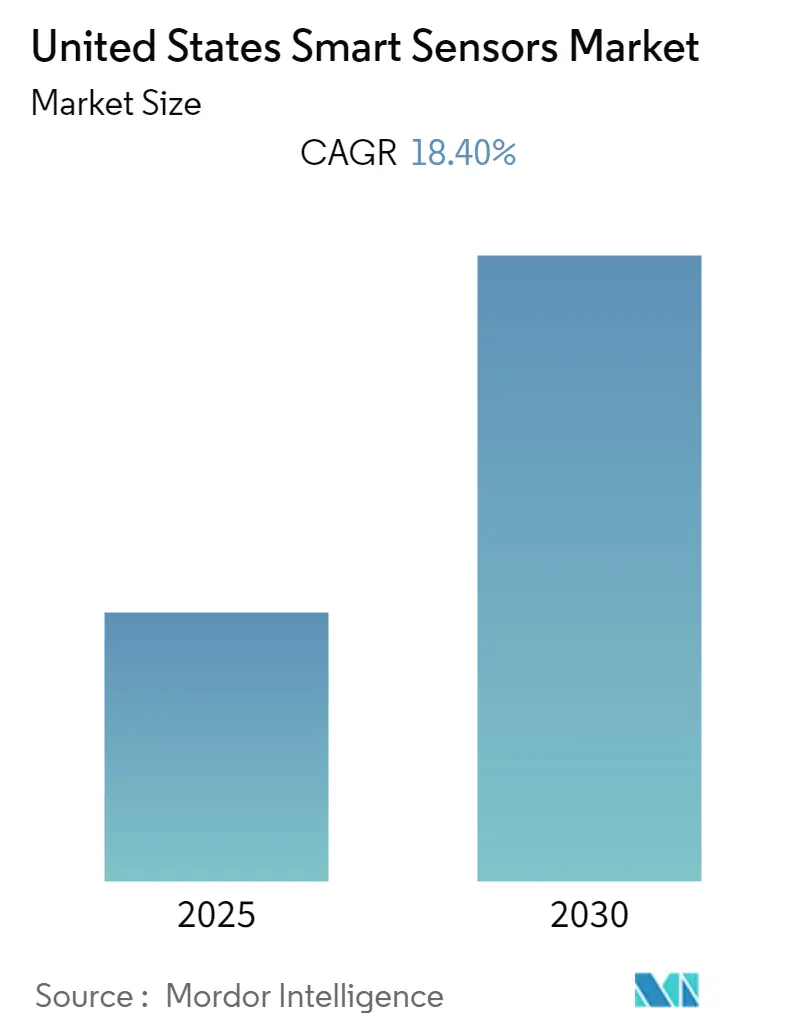
United States Smart Sensors Market Analysis by Mordor Intelligence
The United States Smart Sensors Market is expected to register a CAGR of 18.4% during the forecast period.
- Sensors have become one of the most important and widely used components in various applications. The increasing demand for performance and efficiency has helped in the rising adoption of smart sensors over the past few years.
- These sensors represent an upgrade over conventional sensors, enabling the automated collection of environmental information with a significantly lower error rate. Smart sensors improve the following applications, Self-calibration (Adjust deviation of o/p of sensor form), Communication (Broadcast information about its own status), Cloud support (Access Big Data Analytics and machine learning (ML) algorithms), Cost-effectiveness (Less hardware and reduction of repetitive testing make smart sensors cost-effective), Multi-sensing (A single, smart sensor can measure pressure, temperature, humidity, gas flow and infrared, chemical reaction, surface, acoustic, vapor and more).
- The increasing utilization and penetration of the internet of things (IoT), coupled with increasing automation in vehicles and smart wearable systems for health monitoring, is expected to augment the growth of the smart sensors market over the forecast period. According to a study, nearly 1.3 million people die in road crashes each year, on average, 3,287 deaths per day. Hence, manufacturers are focusing on incorporating the ADAS system in passenger vehicles. Smart sensor technology is used vastly in automobiles for adaptive cruise control, park assistance, blind-spot detection, and collision avoidance.
- Companies that have integrated smart sensors in their manufacturing operations have achieved competitive advantage through improved asset management and predictive maintenance of industrial machinery. At Harley-Davidson's production facility, for example, every asset is connected, allowing management to track each step of production in real-time in a performance management system and monitor critical equipment to address potential interruptions proactively.
- Moreover, industry 4.0 influenced OEMs to adopt IoT across their operations. Maryville University estimated that by 2025 over 180 trillion gigabytes of data would be created globally every year. Industrial IoT (IIoT)IIoT-enabled industries are expected to generate a large portion of the data. A survey by industrial IoT (IIoT) giant Microsoft found that 85% of companies have at least one IIoT use case project. This number is expected to rise, as 94% of respondents said they would implement IIoT strategies by 2021.
- Additionally, the COVID-19 outbreak forced companies globally to adjust their strategies to survive in the "new normal." The outbreak affected the various manufacturing industries, resulting in a temporary shutdown of industrial operations. The supply chain's disruption affected the production of consumer electronics, automotive, healthcare devices, and other sectors, which are prominent adopters of smart sensors.
United States Smart Sensors Market Trends and Insights
Temperature Sensors are Expected to Drive the Market's Growth
- A smart temperature sensor is an integrated system comprising a temperature sensor, bias circuitry, and an analog-to-digital converter (ADC). A temperature sensor measures heat to ensure a process stays within a specific range, providing safe application usage or meeting a necessary condition when dealing with extreme heat, hazards, or inaccessible measuring points. The demand for reliable, high-performance, low-cost sensors is increasing, leading to new technologies like microtechnology and nanotechnology. For the temperature range of -55 to 150°C, bipolar junction transistors are very suited to be applied as temperature sensors because they can be fabricated in almost any standard IC technology, together with other circuitry.
- The low cost, small size, and ease of use led the sensors to widespread use in various industries, such as automobile, residential, medical, environmental, food processing, and chemical. Some of the common temperature sensor types include thermocouples, IR sensors, and thermistors. Temperature sensors find their primary usage in a smart thermostat, a smart home device. The demand for smart homes is forecasted to grow rapidly, owing to robust consumer interest, incremental technological innovations, and greater accessibility.
- The need for minimized contact with surfaces elevated the development of sensor systems for smart home ecosystems. In January 2022, GE Lighting expanded its smart systems portfolio, Cync, by introducing a Smart Thermostat and Temperature Sensor, a line of Outdoor Security Cameras, and additional lighting products to the family of connected products at CES 2022. The cync room temperature sensors work in tandem with their smart thermostat to monitor individual rooms or the entire home and automatically optimize the room temperature.
- Additionally, temperature sensors enable accurate non-contact temperature measurement in healthcare. Physicians use IoT-based temperature trackers to measure ear, forehead, or skin temperature. Responding to the pandemic, FLIR Systems Inc. announced the FLIR A400/A700 Thermal Smart Sensor and Thermal Image Streaming fixed camera solutions for monitoring equipment, production lines, critical infrastructure, and screening for elevated skin temperatures.
- These highly configurable smart camera systems offer accurate and non-contact temperature monitoring across various disciplines: manufacturing process control, product development, waste management, facilities maintenance, emissions monitoring, and Environmental, Health, and Safety (EHS) improvements. The thermal smart sensor configuration, recommended for measuring elevated skin temperatures, incorporates enhanced measurement tools and alarms with edge computing to enable faster critical decisions.
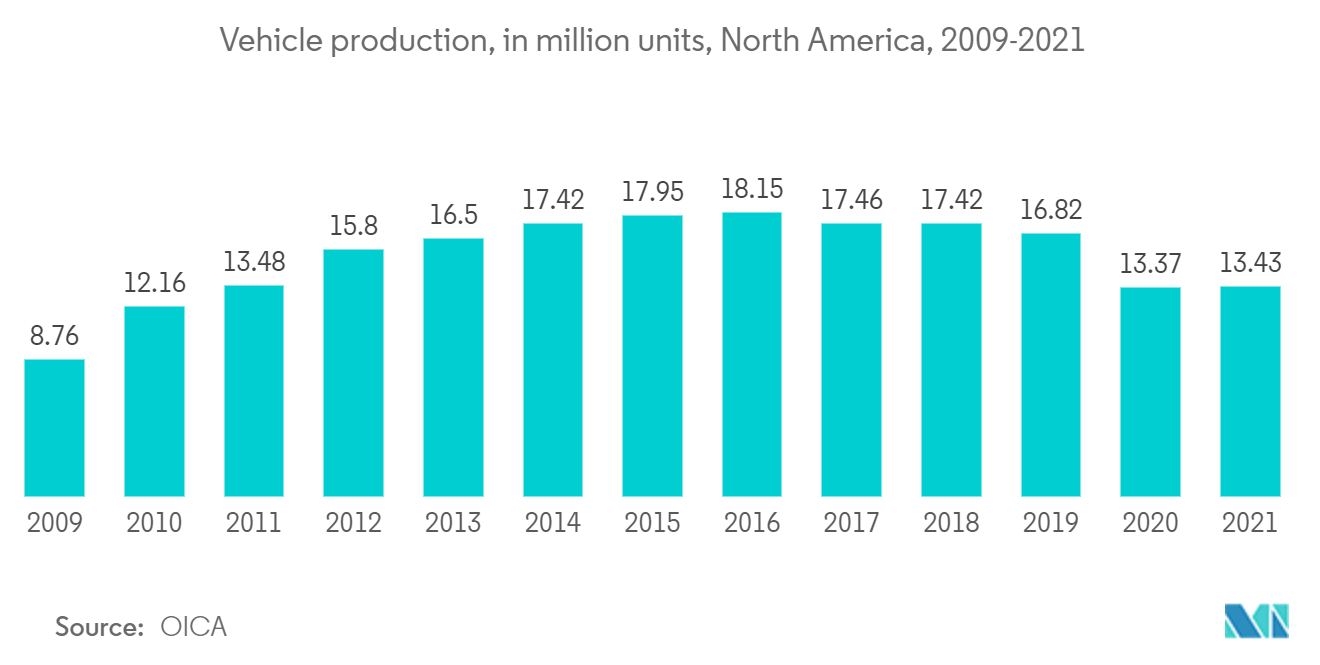
Industrial Automation Segment is Expected to Hold a Major Market Share
- The new industrial IoT (IIoT) technologies are becoming a key component in helping manufacturing companies to maximize the ROI from smart factory initiatives. Massive shifts in manufacturing due to industry 4.0 and the acceptance of IoT require enterprises to adopt agile, smarter, and innovative ways to advance production with technologies that complement and augment human labor with robotics and reduce industrial accidents caused by process failure.
- Smart factories adopt IoT technologies through sensors, robots, software, wireless systems, enterprise software, M2M learning, or other technologies to gather, share, and analyze data. Powered by connectivity and sensors, it generates actionable and near real-time data insights about the condition of physical things in the factory and throughout the supply chain. This, combined with data analytics, new technologies, and a fast network, is helping manufacturers better maintain their assets and boost production efficiency.
- Furthermore, the market penetration of AI and machine learning capabilities may enhance speed, accuracy, and data analysis, significantly driving the market further. The advancement in the field devices market, sensors, and robots may further expand the scope of the studied market.
- The adoption of smart systems can reduce the need for human labor, particularly in challenging environments. Quality control processes have historically relied on human intervention. Nevertheless, with more user-friendly controls, the greater availability of these smart factory systems is expected to gain popularity in complex manufacturing settings.
- Industrial robot technology is a disruptive phenomenon in the manufacturing process and is expected to bring a revolution in the smart factory market. Implementation of industrial robotics has led to advanced production processes that help in improving productivity, reducing human errors, and increasing production volume.
- Through the integration of smart sensors, Smarter factories can help plant managers by providing tools needed to optimize the production process, perform high-speed testing of advanced manufacturing designs, and optimize all logistics. Smart factory technology and IoT devices have far-reaching implications for efficiency, product quality, and safety across the manufacturing value chain. IoT technology can empower elements of smart manufacturing, such as quality assurance, equipment maintenance, warehouse operations, inventory management, and other manufacturing operations.
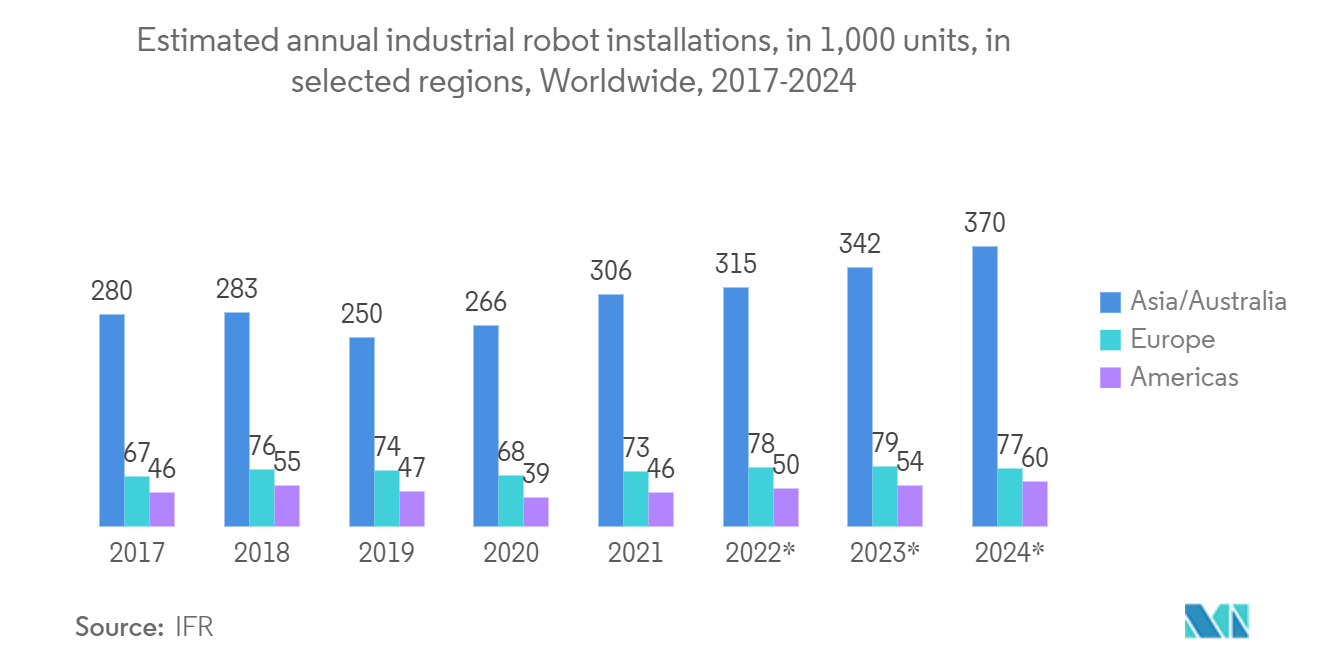
Competitive Landscape
Infineon Technologies AG, Microchip Technology Inc., Analog Devices, Inc., TE Connectivity, STMicroelectronics, Eaton Corporation plc, Honeywell International Inc., and others are among the leading competitors in the United States Smart Sensors Market. The presence of multi-national corporations such as ABB, Siemens, Honeywell, etc., makes the market concentrated. Sensor technology also requires high initial investment along with high continuous research and development of the product.
- December 2021 - Sony Semiconductor Solutions developed a stacked CMOS image sensor with two-layer transistor pixel, doubling saturation signal level, widening dynamic range, and reducing noise relative to conventional image sensors. Such developments in sensor designs are optimized to provide fast, clear, and high-quality video in mission-critical automotive applications' complex and demanding environments.
- July 2021 - Samsung launched the ISOCELL Auto 4AC, its first image sensor that is tailor-made for cars, intended to be used as a reverse camera or (on more advanced systems) to power surround view monitors. It focuses on practical things like a high dynamic range (120 dB) and LED flicker mitigation. They are based on what Samsung calls CornerPixel. This technology combines two photodiodes per pixel - one 3.0 µm for low-light operation and one 1.0 µm placed in the corner (hence the name) that would be used for bright environments.
United States Smart Sensors Industry Leaders
ABB Ltd.
Honeywell International Inc.
Eaton Corporation Plc.
Analog Devices, Inc.
Infineon Technologies
- *Disclaimer: Major Players sorted in no particular order
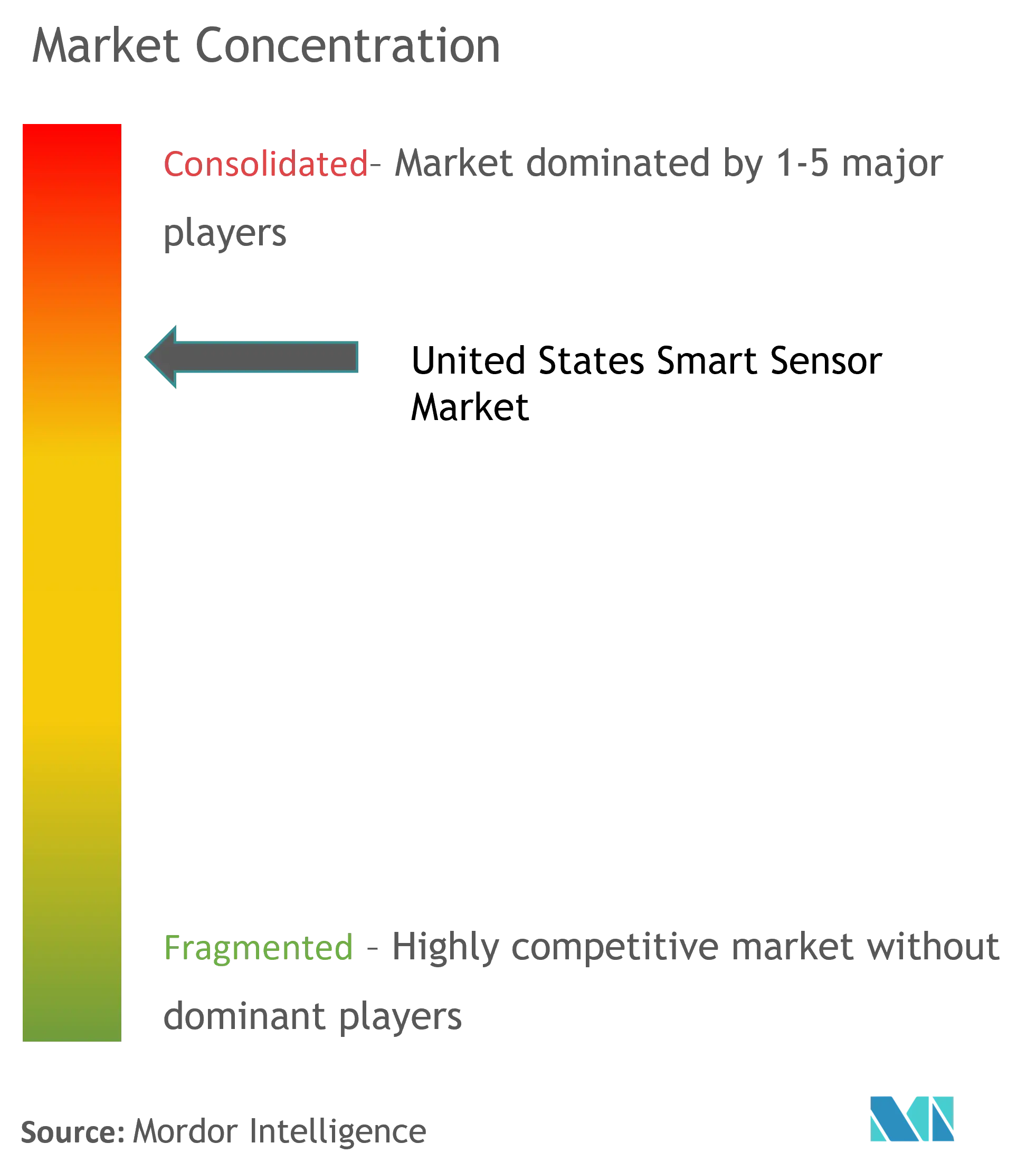
Recent Industry Developments
- December 2021 - Power management company Eaton contracted with the US Department of Defense to manufacture inductive proximity sensors for the Navy to use in aircraft shipboard applications and for evaluation in additional platforms. The sensors incorporate patented technology developed by BH Sensors of Pomona, New York, through the DoD Small Business Innovation Research program.
- March 2021 - Siemens and Senseware announced that Senseware joined the Siemens Connect Ecosystem to bring its scalable IoT platform solutions onto the Siemens Connect Ecosystem, beginning with wireless indoor air quality (IAQ) solutions for in-demand commercial and industrial applications. Senseware's modular IoT architecture rapidly integrates leading-edge IAQ sensors, far outpacing the industry. Siemens and Sensware customers are expected to benefit from the latest technology from sensor manufacturers to address challenges such as the coronavirus pandemic. The partnership will enable buildings in the Siemens Connect Ecosystem to integrate with Senseware technology easily.
United States Smart Sensors Market Report Scope
Sensor with Integrated Circuits forms smart sensors that gather analyses and give instructions as per the built-in logic. Some of the benefits associated with these sensors are scalability, reliability, and cost-effectiveness. These are widely used in industries like aerospace & defense, automotive, consumer electronics, and others.
The United States Smart Sensors Market is segmented by Type (Flow Sensors, Image Sensors, Position Sensors, Pressure Sensors, Temperature Sensors), Technology (MEMS, CMOS, Optical spectroscopy), Component (Analog-to-Digital Converters, Digital-to-Analog Converters, Amplifiers), and by Application (Aerospace and Defense, Automotive and Transportation, Healthcare, Industrial Automation, Building Automation, Consumer Electronics).
| Flow Sensors |
| Image Sensors |
| Position Sensors |
| Pressure Sensors |
| Temperature Sensors |
| Other Types |
| MEMS |
| CMOS |
| Optical Spectroscopy |
| Other Technologies |
| Analog-to-Digital Converters |
| Digital-to-Analog Converters |
| Amplifiers |
| Other Components |
| Aerospace and Defense |
| Automotive and Transportation |
| Healthcare |
| Industrial Automation |
| Building Automation |
| Consumer Electronics |
| Other Applications |
| By Type | Flow Sensors |
| Image Sensors | |
| Position Sensors | |
| Pressure Sensors | |
| Temperature Sensors | |
| Other Types | |
| By Technology | MEMS |
| CMOS | |
| Optical Spectroscopy | |
| Other Technologies | |
| By Component | Analog-to-Digital Converters |
| Digital-to-Analog Converters | |
| Amplifiers | |
| Other Components | |
| By Application | Aerospace and Defense |
| Automotive and Transportation | |
| Healthcare | |
| Industrial Automation | |
| Building Automation | |
| Consumer Electronics | |
| Other Applications |
Key Questions Answered in the Report
What is the current United States Smart Sensors Market size?
The United States Smart Sensors Market is projected to register a CAGR of 18.4% during the forecast period (2025-2030)
Who are the key players in United States Smart Sensors Market?
ABB Ltd., Honeywell International Inc., Eaton Corporation Plc., Analog Devices, Inc. and Infineon Technologies are the major companies operating in the United States Smart Sensors Market.
What years does this United States Smart Sensors Market cover?
The report covers the United States Smart Sensors Market historical market size for years: 2019, 2020, 2021, 2022, 2023 and 2024. The report also forecasts the United States Smart Sensors Market size for years: 2025, 2026, 2027, 2028, 2029 and 2030.
Page last updated on:
United States Smart Sensors Market Report
Statistics for the 2025 United States Smart Sensors market share, size and revenue growth rate, created by Mordor Intelligence™ Industry Reports. United States Smart Sensors analysis includes a market forecast outlook for 2025 to 2030 and historical overview. Get a sample of this industry analysis as a free report PDF download.
